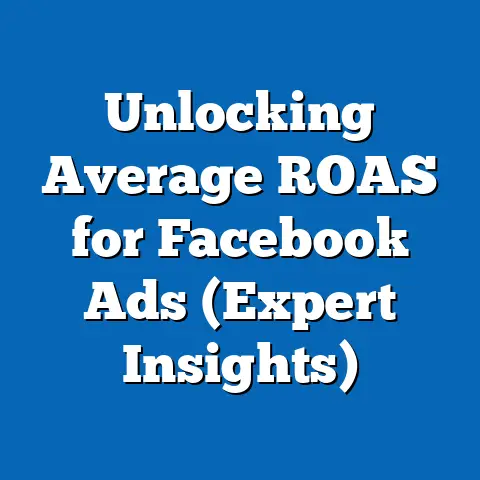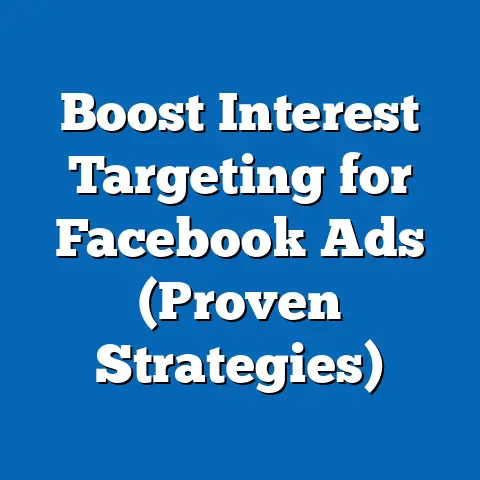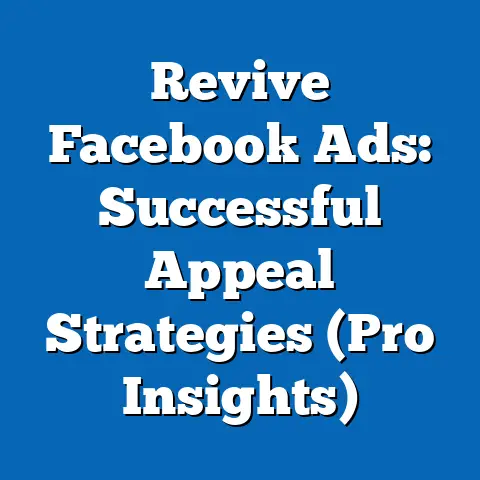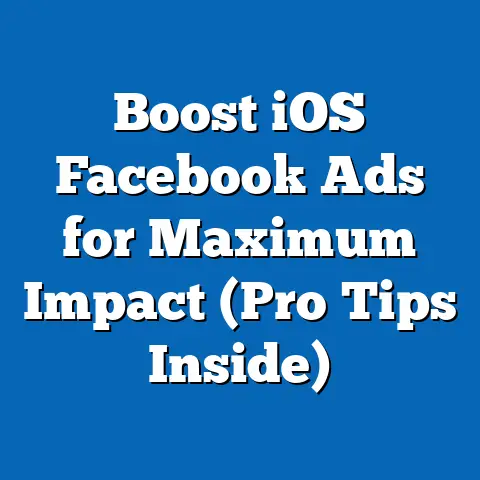Master Facebook Ads: Avoid These Banned Words (Critical Tips)
Mastering Facebook Ads: Avoid These Banned Words (Critical Tips)
Introduction: The Power and Peril of Words in Digital Advertising
“After spending weeks crafting the perfect ad for my small business, I was shocked when Facebook rejected it over a single word I didn’t even realize was problematic. It cost me time, money, and missed opportunities—I wish I had known the rules upfront,” shares Emily Carter, a 34-year-old entrepreneur from Seattle who runs an online fitness coaching service. Emily’s experience is far from unique; countless advertisers, from solo entrepreneurs to large corporations, have faced the frustration of having their meticulously designed Facebook ads rejected due to violations of the platform’s strict advertising policies.
Section 1: Defining Characteristics of Facebook Ads Compliance
Facebook Ads operate within a tightly regulated ecosystem designed to protect users from harmful, misleading, or inappropriate content. At the core of these regulations is the platform’s Advertising Policies, which outline prohibited content, restricted categories, and specific language guidelines. Understanding these rules is essential for advertisers aiming to reach their target audience without facing rejections or account suspensions.
One key characteristic of compliant ads is the avoidance of “banned words” or phrases that trigger automatic flags in Facebook’s review system. These include explicit language, terms implying personal attributes (e.g., “are you depressed?”), and sensationalized claims (e.g., “miracle cure”). According to a 2022 report by Hootsuite, nearly 30% of ad rejections stem from improper language use, highlighting the importance of word choice.
Additionally, compliant ads must align with community standards, ensuring content is neither discriminatory nor offensive. This requires advertisers to adopt a user-centric approach, focusing on value-driven messaging rather than exploitative tactics. However, nuances exist—words deemed acceptable in one context may be flagged in another, depending on cultural or regional interpretations, emphasizing the need for adaptability and research.
Section 2: Historical Context of Facebook Ads Policies
To understand the current landscape of banned words and content restrictions, it’s critical to examine the historical evolution of Facebook’s advertising policies. When Facebook Ads launched in 2007, the platform was a relatively open space with minimal oversight, allowing advertisers significant creative freedom. Early ads often included exaggerated claims and personal targeting that would be unacceptable today.
The turning point came in the early 2010s, as public scrutiny over data privacy and content moderation grew following high-profile incidents like the 2011 FTC settlement over deceptive privacy practices. By 2016, the Cambridge Analytica scandal—where user data was misused for political advertising—further intensified calls for stricter regulations. Facebook responded by overhauling its ad policies, introducing automated content filters and banning specific language tied to discrimination, misinformation, and sensitive topics.
Significant events like the 2020 U.S. presidential election and the COVID-19 pandemic also shaped these policies. During the pandemic, Facebook banned ads promoting unverified health claims (e.g., “cure COVID with this supplement”), reflecting a broader societal push for accurate information. This historical context reveals how external pressures—legal, cultural, and political—have driven the platform to prioritize user safety over advertiser flexibility, creating the complex policy framework we see today.
Section 3: Key Banned Words and Categories to Avoid
Navigating Facebook’s banned words list requires a deep understanding of specific terms and thematic categories that trigger rejections. While the platform does not publish an exhaustive list—partly to prevent workarounds—extensive research and community feedback have identified common culprits. Below are critical categories and examples of banned or restricted language:
-
Personal Attributes and Direct Targeting: Words or phrases that imply knowledge of a user’s personal traits, such as “are you overweight?” or “struggling with debt?” are prohibited. These violate Facebook’s policy against personalized assumptions, which aims to prevent discrimination and protect user privacy.
-
Sensationalized or Misleading Claims: Terms like “miracle,” “instant cure,” or “guaranteed results” are often flagged for being deceptive. A 2021 study by AdEspresso found that ads with hyperbolic language were rejected 40% more frequently than those with neutral claims.
-
Profanity and Offensive Language: Explicit words or hate speech are automatic grounds for rejection, aligning with Facebook’s Community Standards. Even mild slang can be flagged depending on context or regional sensitivities.
-
Sensitive Topics: Language related to controversial issues like politics, religion, or health crises (e.g., “anti-vaccine”) often requires pre-approval or is outright banned. During the COVID-19 pandemic, over 12 million pieces of content were removed for misinformation, many tied to ad campaigns (Facebook Transparency Report, 2021).
Advertisers must also consider visual and contextual elements, as banned words can appear in images or implied through tone. The key takeaway is to prioritize transparency, neutrality, and respect for user boundaries when crafting ad copy.
Section 4: Technological and Economic Factors Influencing Ad Policies
The enforcement of banned words on Facebook Ads is heavily influenced by technological advancements and economic incentives. On the technological front, Facebook employs sophisticated AI and machine learning algorithms to scan ads for policy violations before they go live. These systems analyze text, images, and even user engagement patterns to detect problematic content, though they are not infallible—contextual errors often lead to false positives, as Emily Carter’s experience illustrates.
Economically, Facebook’s policies reflect a balancing act between revenue generation and user trust. Advertising accounts for over 90% of Meta’s revenue, with $114.9 billion earned in 2022 alone (Meta Annual Report, 2022). However, user backlash over inappropriate ads can damage the platform’s reputation, leading to stricter rules on language and content. This tension underscores why policies are often reactive, evolving in response to public sentiment or regulatory pressure rather than proactively addressing advertiser needs.
Moreover, the global nature of Facebook’s audience introduces economic disparities in ad compliance. Small businesses in developing regions, lacking resources for legal or marketing expertise, face higher rejection rates compared to multinational corporations, exacerbating digital divides. Understanding these technological and economic dynamics is crucial for advertisers seeking to navigate the system effectively.
Section 5: Social and Cultural Implications of Content Moderation
Culturally, the global application of uniform policies often overlooks regional nuances, leading to friction. A term deemed harmless in one culture may be offensive in another, yet Facebook’s automated systems rarely account for such subtleties. This raises questions about cultural equity in digital spaces—whose values are prioritized when defining “acceptable” language?
Furthermore, content moderation influences societal trust in technology platforms. A 2023 Pew Research Center survey found that 59% of users believe social media companies overstep in content regulation, while 41% feel they do too little to address harmful content. This polarization highlights the challenge of balancing user safety with creative freedom, a tension that advertisers must navigate when crafting compliant yet impactful ads.
Section 6: Practical Tips for Mastering Facebook Ads
To avoid the pitfalls of banned words and policy violations, advertisers must adopt strategic approaches grounded in research and best practices. Below are actionable tips to ensure compliance while maximizing ad effectiveness:
-
Research and Test Language: Use tools like Facebook’s Ad Library to analyze successful ads in your niche, noting language patterns. Test variations of copy to identify what resonates without triggering flags.
-
Focus on Value-Driven Messaging: Instead of sensational claims, emphasize benefits and solutions (e.g., “Discover tips for better health” rather than “Cure your illness instantly”). This aligns with user expectations and policy guidelines.
-
Leverage Pre-Approval Processes: For sensitive topics like health or finance, submit ads for pre-approval to avoid delays. Familiarize yourself with restricted categories outlined in Facebook’s policy documentation.
-
Stay Updated on Policy Changes: Policies evolve frequently, often in response to global events. Subscribe to Meta’s business updates or join advertiser communities for real-time insights.
-
Seek Professional Guidance: For small businesses like Emily Carter’s, hiring a digital marketing consultant or using ad management tools can prevent costly mistakes. A 2022 survey by Social Media Examiner found that 68% of businesses using professional services reported fewer ad rejections.
By integrating these strategies, advertisers can craft compelling campaigns that adhere to guidelines while achieving their marketing goals.
Section 7: Workplace and Industry Implications
The complexities of banned words and content policies on Facebook Ads have far-reaching implications for the marketing industry and workplace dynamics. For marketing teams, staying compliant requires continuous education on policy updates, often straining resources and time. Larger firms may absorb these costs, but small businesses and freelancers face disproportionate challenges, potentially widening industry inequities.
In the workplace, the need for compliance fosters new roles and skill sets, such as content moderation specialists and policy analysts. LinkedIn data from 2023 shows a 25% increase in job postings for digital advertising compliance roles, reflecting growing demand for expertise in navigating platforms like Facebook.
Moreover, ad policies influence how brands communicate with consumers, pushing industries toward ethical marketing practices. While this shift promotes transparency, it also limits creative expression, prompting debates over whether stringent rules stifle innovation. These dynamics underscore the broader impact of content moderation on professional landscapes and industry standards.
Section 8: Nuances and Diversity in Ad Compliance Challenges
While general guidelines for avoiding banned words apply universally, significant nuances and diversity exist in how advertisers experience compliance challenges. For instance, language barriers affect non-native English speakers, whose ads may be flagged due to unintentional mistranslations or cultural missteps. A 2021 study by the Digital Marketing Institute found that 35% of global advertisers cited language as a primary barrier to Facebook Ads success.
Industry-specific challenges also play a role. Health and wellness brands face stricter scrutiny than retail or entertainment sectors, requiring tailored strategies. Similarly, geographic diversity impacts compliance—advertisers in heavily regulated markets like the EU must navigate additional legal constraints tied to data protection laws like GDPR.
Acknowledging these differences prevents oversimplification of ad compliance as a “one-size-fits-all” issue. Advertisers must adopt flexible, context-aware approaches to address the unique hurdles they face, ensuring inclusivity in digital marketing success.
Section 9: Forward-Looking Insights and Uncertainties
As digital advertising continues to evolve, the landscape of banned words and content policies on Facebook Ads will likely undergo further transformation. Emerging technologies like generative AI could enhance ad personalization but also complicate compliance, as AI-generated content may inadvertently include flagged language. Meta’s ongoing investment in AI moderation tools suggests a future of even stricter, yet potentially more accurate, content filters.
Regulatory pressures will also shape policy trajectories. With governments worldwide tightening oversight of social media platforms—evidenced by the EU’s Digital Services Act of 2022—advertisers may face additional layers of compliance, balancing platform rules with legal mandates. This convergence of technology and regulation introduces uncertainties about how much creative freedom advertisers will retain.
Looking ahead, collaboration between platforms, advertisers, and policymakers will be crucial to strike a balance between user protection and marketing innovation. While the path forward remains unclear, proactive adaptation—through education, technology adoption, and ethical practices—will empower advertisers to thrive in an ever-changing environment.
Conclusion: Navigating the Future of Facebook Advertising
Mastering Facebook Ads in the face of banned words and content restrictions is both a challenge and an opportunity for advertisers. As Emily Carter’s story illustrates, a single misstep can derail a campaign, yet understanding the platform’s policies unlocks vast potential to connect with billions of users. This article has explored the defining characteristics of compliant advertising, traced the historical evolution of ad policies, and unpacked the technological, economic, social, and cultural factors at play.
The societal implications of content moderation extend beyond individual ads, influencing public discourse, cultural equity, and industry standards. By adopting practical strategies and embracing the nuances of compliance challenges, advertisers can navigate this complex landscape with confidence. Looking to the future, while uncertainties loom, a commitment to ethical, user-focused marketing will remain the cornerstone of success in the dynamic world of Facebook advertising.






